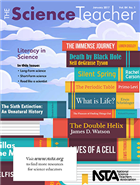Science 2.0: Help Students Become Innovative Designers
By sstuckey
Posted on 2017-01-23
Our past three columns described how teachers can implement the first three Empowered Learner Standards established by the International Society for Technology in Education (ISTE). This month, we focus on classroom strategies to support the fourth standard: Innovative Designer.
The performance indicators in the Innovative Designer standard align with the practices of scientific inquiry, which help students conduct scientific investigations. Students become innovative designers once they meet these performance indicators:
- know and use a deliberate design process for generating ideas, testing theories, creating innovative artifacts or solving authentic problems;
- select and use digital tools to plan and manage a design process that considers design constraints and calculated risks;
- develop, test, and refine prototypes as part of a cyclical design process; and
- exhibit a tolerance for ambiguity, perseverance, and the capacity to work with open-ended problems (ISTE 2016). (italics added)
It’s worth noting that only the second performance indicator, where students plan and manage the design process, actually requires using technology. For this indicator, digital mapping tools (e.g., Lucidchart, MindMap) work well.
Defining innovation
Innovation implies that students must come up with something new or original and is often associated with great improvements to the way of life. This is a paradigm that science teachers must shift.
Accomplishments by companies such as Tesla or Apple are the exception, not the norm, and may only serve as a form of inspiration. Teachers should encourage students to be motivated by their successes and learn from their practices, but we must establish a classroom culture and norms that allow students to experience innovation in their own right.
Simplifying innovation
Tony Wagner, author of Creating Innovators, makes the compelling argument that innovation is really just the act of creative problem solving. To foster this type of behavior, he says, a classroom must promote passion, play, and purpose. Creating a classroom culture that grows innovative designers should therefore be examined through the lens of these “three Ps.”
However, not all activities need to promote this definition of innovation. Traditional types of activities are often the necessary foundation for students to learn scientific investigation. Students should still follow prescribed steps that allow them to learn measurement, instrumentation, and observation. However, once students become proficient in these skills, they should begin to choose their own learning path to foster the three Ps.
Science classroom innovation
When students explore their passions and are given the opportunity to find authentic problems with purpose, students will find that their work feels more like play. The timeless quote by Ray Bradbury, “Love what you do, do what you love…” could never be more applicable as when students find passion and purpose in their work.
Teachers can begin activities with simple questions, “Tell us what waves do?” “Show us how a chemical reaction works.” and “Is our local stream healthy?” Although such questions are derived from traditional activities, students can take ownership of each question when they choose their path and add purpose to their work. Finally, students also need to develop a tenacious approach to these problems so they demonstrate grit. When that happens, we begin to see innovation.
Ben Smith (ben@edtechinnovators.com) is an educational technology program specialist, and Jared Mader (jared@edtechinnovators.com) is the director of educational technology, for the Lincoln Intermediate Unit in New Oxford, Pennsylvania. They conduct teacher workshops on technology in the classroom nationwide.
Reference
International Society for Technology in Education (ISTE). 2016. The 2016 ISTE standards for students. Arlington, VA: ISTE. http://bit.ly/ISTE-standards
Editor’s Note
This article was originally published in the January 2017 issue of The  Science Teacher journal from the National Science Teachers Association (NSTA).
Science Teacher journal from the National Science Teachers Association (NSTA).
Get Involved With NSTA!
Join NSTA today and receive The Science Teacher,
the peer-reviewed journal just for high school teachers; to write for the journal, see our Author Guidelines, Call for Papers, and annotated sample manuscript; connect on the high school level science teaching list (members can sign up on the list server); or consider joining your peers at future NSTA conferences.
Disclaimer: The views expressed in this blog post are those of the author(s) and do not necessarily reflect the official position of the National Science Teaching Association (NSTA).


